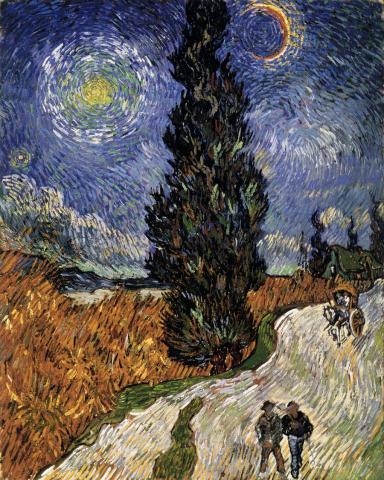-
Table of Contents
- 0. STORY PREFACE
- 1. EARLY LIFE
- 2. AN ARTIST IS BORN
- 3. STUDYING ART, FEELING PAIN
- 4. THE FIRST MASTERPIECE
- 5. THE PARIS YEARS
- 6. INFLUENCE of JAPANESE ART
- 7. EARLY LIFE in ARLES
- 8. THE BANDAGED EAR
- 9. VINCENT at SAINT-REMY
- 10. THE ATTACKS CONTINUE
- 11. PAINTING in AUVERS-sur-OISE
- 12. WORRIES and TURMOIL
- 13. VINCENT COMMITS SUICIDE
- 14. THE SADNESS WILL LAST FOREVER
After he was released from Saint-Paul Hospital in Saint-Rémy, Vincent visited his brother in Paris, then traveled to Auvers-sur-Oise. After arriving in this picturesque French town, Vincent painted almost constantly. This oil-on-canvas, which measures 92 x 73 cm, depicts “Road with Cypress and Star.” Vincent created it during May of 1890. Today it is owned by the Rijksmuseum Kröller-Müller, Otterlo. Click on the image for a better view.
After spending a few days in Paris with Jo, Theo and their new baby (named after him), Vincent arrived (on the 20th of May, 1890) at his new destination - a picturesque village, favored by artists. He rented a room at Arthur Gustave Ravoux's inn at Auvers-sur-Oise (Auvers on the River Oise).
It would soon be summer, and Auvers was filled with, and surrounded by, gorgeous scenery. Van Gogh wasted no time drawing and painting his impressions of the town and interpreting one beautiful scene after another.
In early June, Theo and his family paid a visit. Vincent was under the care of Dr. Gachet and appeared to be doing well.
Then ... bad news: Van Gogh learned that his namesake was very sick. Unknown to Vincent, the baby's illness wasn't the only problem Theo and his new wife were trying to manage. Theo - who was still supporting his brother - had serious concerns about his own health, his career and his financial future.
After the child was better, Vincent paid a visit on the 6th of July, 1890. Likely not expecting turmoil when he arrived, van Gogh soon realized that Theo's circumstances were not ideal. In her later memoir, Jo noted (scroll down 90%) "those were days of much ."
Returning to Auvers, Vincent created at a frenzied pace. His output of brilliant work was astonishing. Averaging nearly a painting a day that summer, he wrote to his mother and sister that he was reasonably calm:
For the present I am feeling much calmer than last year, and really the restlessness in my head has greatly quieted down. (Vincent to Mother and Sister, 10-14 July, 1890.)
Keeping his focus on such things as fields, plains, cottages and flowers in and around Auvers, the thirty-seven-year-old painter was in top artistic form. He visited the home and grounds (especially the garden) of a then-deceased artist whom he greatly admired - Charles Daubigny - whose widow still lived in the house.
His summer masterpieces include:
- Church at Auvers (compare it to the actual place)
- Wheat Field with Crows
- Daubigny's Garden (with a black cat)
Under the surface of his apparent calmness, however, something must have been bothering Vincent. All was not well when he decided to go into the Auvers wheat fields - which he had often painted with such brilliance - on the evening of July 27, 1890.
-
Table of Contents
- 0. STORY PREFACE
- 1. EARLY LIFE
- 2. AN ARTIST IS BORN
- 3. STUDYING ART, FEELING PAIN
- 4. THE FIRST MASTERPIECE
- 5. THE PARIS YEARS
- 6. INFLUENCE of JAPANESE ART
- 7. EARLY LIFE in ARLES
- 8. THE BANDAGED EAR
- 9. VINCENT at SAINT-REMY
- 10. THE ATTACKS CONTINUE
- 11. PAINTING in AUVERS-sur-OISE
- 12. WORRIES and TURMOIL
- 13. VINCENT COMMITS SUICIDE
- 14. THE SADNESS WILL LAST FOREVER


 Back
Back
 Next Chapter
Next Chapter

 Back
Back
 Next Chapter
Next Chapter


